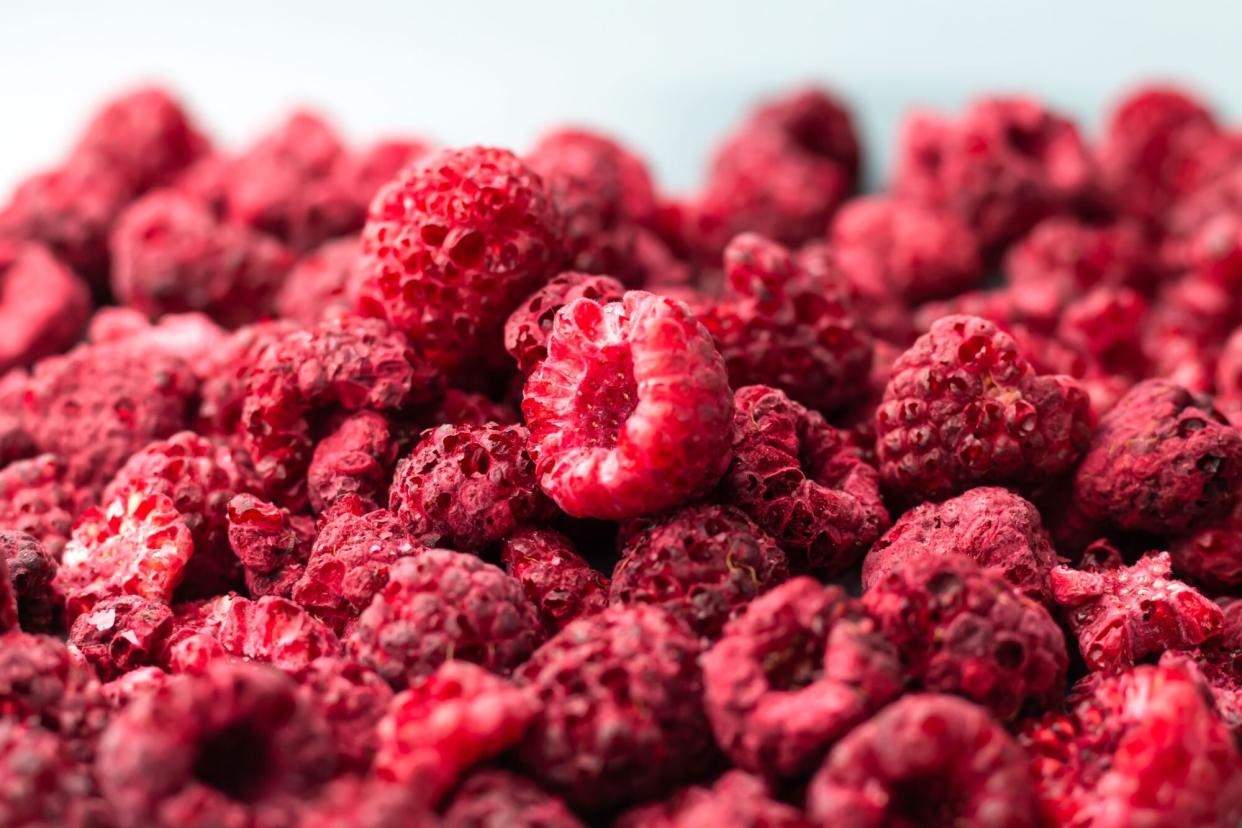Freeze-Dried Fruit Is a Smart Way to Add Flavor to Cakes, Cookies, and Other Foods—Any Time of the Year

Dmitriy Sidor / GETTY IMAGES
TABLE OF CONTENTS
On This Page
What Is Freeze-Dried Fruit?
Freeze-Dried vs. Dehydrated Fruit
How to Use
How to Store
When you want to incorporate the bright, vibrant flavors and colors of your favorite fruits into cakes, cookies, desserts, and snacks, even when they're not in season, turn to freeze-dried fruits. Although they may look like they belong in the gift shop at NASA, freeze-dried fruits have been making their way into grocery stores in recent years. Learn what this space-age food is and how to use it in your kitchen.
Related: How to Cut a Perfect Slice of Pie
What Is Freeze-Dried Fruit?
Yes, freeze-dried fruit is real fruit—it has simply been subjected to a commercial freeze dryer. This machine removes moisture from the fruit using cold temperatures. Freeze-dried fruit is completely dry, lightweight, and has a crisp, crumbly texture. As for how it tastes? Freeze-dried fruit is "bright and full of the flavor of whatever [fruit] it is," says recipe developer and stylist, Sarah Carey, our former director of food and entertaining.
The Process
The process of drying fruits (and other foods) is as old as the sun, but freeze drying uses contemporary technology. Foods placed within a commercial freeze dryer are frozen to sub-zero temperatures. Once frozen, the foods are subjected to vacuum drying using a vacuum pump. The air and water vapor are removed from the processing chamber, which includes removing the water vapor that was once inside the food. The food is then dry enough to store safely at room temperature.
Freeze-Dried vs. Dehydrated Fruit
Dehydrated or dried fruit is made by a completely different process that uses a specialized oven-like machine, heating the fruit for long periods of time to dry it. Compared to freeze-dried fruit, dehydrated fruit is leathery, chewy, and still contains about one-third of its moisture content. Because freeze-dried fruit contains no moisture, its shelf life is much longer than dehydrated fruit. In fact, its shelf life is probably longer than everything else in your kitchen. When properly stored, it has been known to last as long as 25 to 30 years.
Freeze-dried fruit still contains most of its nutrients, sugars, and most importantly, flavors, since freeze drying only removes the water from the fruit. On the other hand, heat in the dehydrating process strips fruit of nutrients and changes the flavors when cooked.
How to Use Freeze-Dried Fruit
You can buy freeze-dried fruit at many grocery stores (it's often in the same aisle as dehydrated fruits like raisins), but how should you use it? Since freeze-dried fruit contains no water or added sugar, it's ideal for bringing fresh, bright flavors to baked goods without the concern of disturbing the consistency or sweetness of a batter or dough.
Make a Powder for Frosting, Whipped Cream, Cake Batter, and More
In a food processor, pulverize any freeze-dried fruit—strawberries, raspberries, mango, or apples—to make a powder that folds and dissolves effortlessly into cake batter, whipped cream, buttercream frosting, meringues, and more. Sift that same powder over the top of a shaken egg white cocktail, or dust it over popcorn for a sweet-and-salty treat.
"It is so great for baking because it adds tons of fruit flavor, but no liquid, so you can play with it in recipes that normally would be so hard to make fruity, like cookies," says recipe developer and cookbook author Yossy Arefi, who incorporates freeze-dried fruit in a number of recipes in her book Snacking Cakes.
Add to a Syrup for Drinks and Desserts
For rich, beautifully colored syrups, add any freeze-dried fruit to a small saucepan with equal parts water and granulated white sugar. Bring to a simmer, let reduce, and then strain into jars or glass bottles for an ingredient that is as pretty as it is practical. Drizzle it onto ice cream or yogurt, add to your favorite cocktail or mocktail, use it to sweeten tea, or even to top waffles or French toast.
Use Whole
Even when left whole or roughly crumbled, freeze-dried fruit is a fun and unique addition to trail mix or snack mix, breakfast bars, cereal or oatmeal, and much more. First-time users should know that it packs a punch. "I'd say start small," says Riley Wofford, recipe developer and food stylist. "And adjust according to your taste buds."
How to Store Freeze-Dried Fruit
To preserve freeze-dried fruit in your kitchen, keep the fruit in a zip-top bag and place in an airtight canister in a dry and cool space—staving off any excess sunlight or humidity. "In many cases, you are going to want to grind the fruit before you use it, so make sure to seal the packages well after opening," says Arefi. "When moisture touches it, the fruit gets soft and chewy doesn't work as well then for that application."
If the package you buy comes with a small packet of desiccant silica gel, feel free to throw that into whatever bag or container you use to store leftover fruit.

